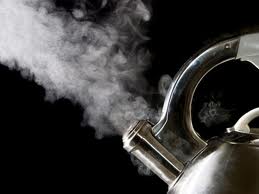
Since early childhood, we have all been taught about the dangers of being burned by hot liquids, steam, and fire, with our parents and grandparents constantly shooing us away from ovens, stoves, and flames. But many of us are unaware of the harm that can come from using everyday hot water bottles and heating pads: They can severely burn our flesh without any warning of sharp pain.
Our bodies react quickly to contact with boiling water, causing an instantaneous reflex that draws us quickly away from danger. But these instincts that save us so reliably can be fooled when we let our guard down. Falling asleep with a hot water bottle or heat patch against the skin can result in a burn that is more serious than many people would guess.
College student Shen Kang learned this lesson the hard way.
A few nights ago, she filled up her hot water bottle, an evening ritual as she had taken to using it to keep her warm in bed on cold winter nights. But when she suddenly woke up in the middle of the night, she found that her lower leg, which was resting on top of the bottle, would not move.
"I noticed a few blisters on the area, and it was itchy and painful. Then I realized I had probably burned myself," she told the Global Times. "I grabbed my mobile phone and googled the symptoms, and found out that I had a low-temperature burn, something I'd never even heard of. I'd never imagined I could get an actual burn from a hot water bottle!"
Shen went to the hospital the next day, and was diagnosed with a first-degree burn, luckily the least dangerous level of burn.
Since then, she has had to visit the hospital on a regular basis to have her bandages changed in order to avoid infection. The doctor told her that her condition would have been worse had she not gone to the hospital in time.
"Low-temperature burns are similar to more common burns in that they are inflicted by exposure to heat, but they differ in that they are caused by a milder temperature that toasts the skin for a longer period," explained Kang Yudong, director of the surgical department at Beijing Hospital of Traditional Chinese Medicine.
"While healthy people may experience a mild burn from falling asleep with a water bottle in contact with their skin, people who are less sensitive to temperature, such as those suffering from diabetes, can develop more serious low-temperature burns."
Kang told the Global Times that her hospital is currently treating many diabetic patients with burned feet. Many people with type 2 diabetes have poor circulation, especially in the feet, making low-temperature burns more common, she said.
"Like anyone else, these patients like to put their feet on a hot water bottle or a heating pipe during the winter. But they can get badly burned because the nerves in their feet respond slowly. They also tend to suffer from infection more easily than healthy people, so in some cases, such burns can be life threatening."
Popular and convenient heating elements, such as disposable heat patches, hot water bottles and electronic hand warmers, can all pose a potential danger if not used properly, resulting in unexpected burns.
"The symptoms of a first-degree burn include pain, redness and minor swelling," she said. "A second-degree burn is characterized by sharp pain, blisters, and swelling. If someone has a second-degree burn, medical attention should be sought immediately. Third-degree burns involve nerve damage and tissue destruction, which is extremely dangerous.
"To healthy people, the chances of getting seriously burned by personal heating elements are small, and most cases can be treated in the outpatient department," said Kang.
According to some news reports, skin can be burned from one minute of contact with an item that is 70°C in temperature, or five minutes of contact with something that registers at 60°C. Kang says not to put too much stock in the exact timing, adding that one can never be too careful.
Copy writer Li Jia has been aware of the dangers of low-temperature burns for years, but she still burned herself recently when she took a quick nap at the office. Settling her head down on her desk, Li made the mistake of putting her hands in a comfortable USB-powered hand warmer.
"It was a plush glove with an electric sheet inside. It will start to heat as soon as it is plugged into the computer," she said. "My hands were red from the burns and I ended up at the hospital.
"It reminded me of an old folk saying: If you throw a frog in boiling water, it jumps out; if you put the frog in cold water and slowly turn up the heat, the frog won't notice the danger and will eventually allow itself to be cooked to death," she added.

Copyright ©1999-2011 Chinanews.com. All rights reserved.
Reproduction in whole or in part without permission is prohibited.